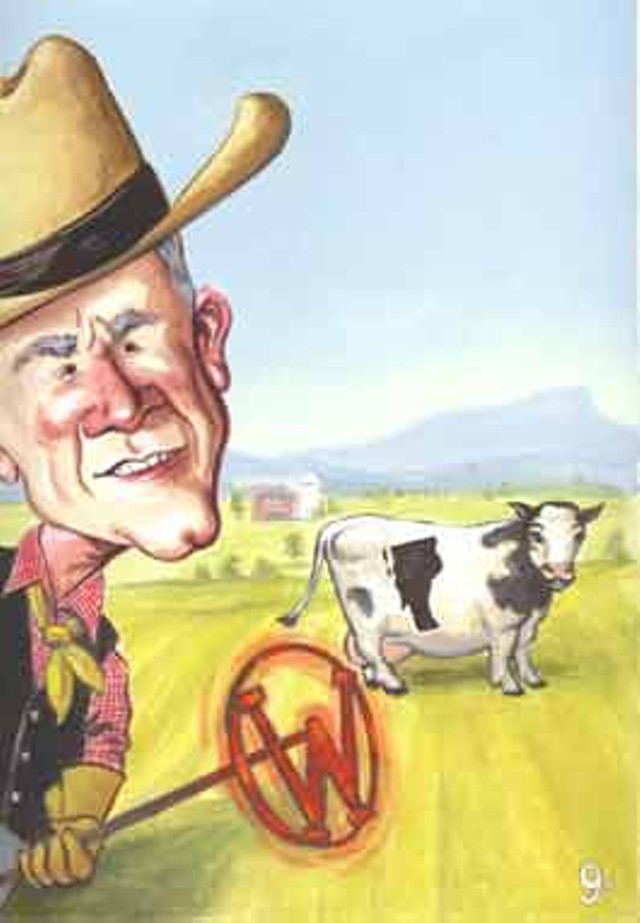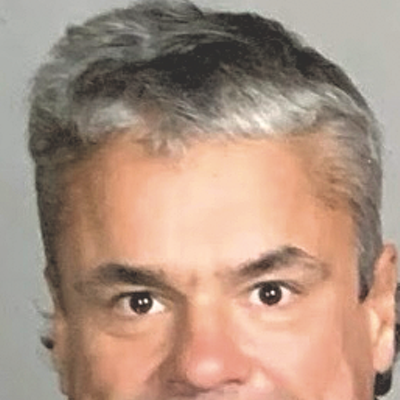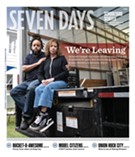Published January 10, 2001 at 9:18 p.m.
Okay, the holidays are over. Let’s get those conspiracy caps back on. A draft-dodging, grammar-impaired, drunk-driving governor from Texas — without much visible swagger — is about to be inaugurated as President of the United States, and MGM Home Entertainment is releasing a special 40th Anniversary DVD edition of The Alamo, produced, directed and starred in by none other than John Wayne.
As the re-release publicity notes, “Wayne, decked out in buckskin jacket and coonskin cap early in the film, acquits himself well as the good-natured frontiersman Davy Crockett, who leads a band of Tennesseans into Texas, where they join the fight for freedom.” And later, “The overriding theme is that freedom is such a cherished thing that men were willing to not only fight for it, but die for it.”
Coincidence? Get real. It’s all about the coming Texas World Order and the “Texafication” of American life — the ongoing process of injecting fresh doses of discredited Texan, and Western, mythology into the political and cultural mainstream of America.
That mythology is about a lot more than saddles, spurs, saloons, Stetsons and six-guns. The myth of Texas begins with all the variants of formerly conventional history that basically portrays American history as White Men moving West to bring peace, economic progress and civilization to a hostile land. As Congressman John Wentworth of Illinois put it in the 1840s, Manifest Destiny meant that America would be “the great center from which civilization, religion, and liberty should radiate and radiate until the whole continent shall bask in their blessing.”
Under this pioneering halo, Texas becomes a freedom-loving, frontier-settling, oil-discovering, law-and-ordering, civilization-bringing, border-protecting, bigger-is-bettering, Bible-Belting and nature-conquering bastion of “the great American spirit.” It’s an America with clear moral absolutes — where right and wrong are, of course, black and white. No gray cowboy hats, please.
The Inaugural Address is a perfect stage for Bush to weave Texas myths ever deeper into our national consciousness. President Ronald Reagan, in some ways more of a cowboy than Connecticut-born and Ivy-educated W. will ever be, gave us a taste in his second Inaugural:
“The men of the Alamo call out encouragement to each other; a settler pushes west and sings his song, and the song echoes out forever and fills the unknowing air.
“It is the American sound: It is hopeful, big-hearted, idealistic, daring, decent and fair. That’s our heritage, that’s our song. We sing it still. For all our problems, our differences, we are together as of old…”
So you weren’t paying that much attention in January 1985? Well, it’s a fair bet that George W. will proclaim the words “Alamo,” “freedom” and “sacrifice” in his address this month. An even safer bet would be that he says “Alamo” (188 American fatalities) before the word “AIDS” (430,441 American fatalities, 16.3 million worldwide).
Texafication is an ugly process and, like your fire-and-brimstone revivalist preacher, hard to stop once under way. So someone’s gotta take on the mantle of the Anti-Texas — you know, accept the challenge of shearing off the wool that certain Texans will try to pull over America’s eyes.
I nominate Vermont.
Truth be told, we Vermonters have been coasting along for years, getting our jollies from picking on little ol’ New Hampshire. Come on, now, Green Mountain Boys and Girls, it’s time to aim our smugness arrows in a new direction.
New Hampshire has been way too easy. It’s just sitting over there across the Connecticut River, content as a simpleton in the spring sun, with its dysfunctional legislature, billboards, roadside liquor stores and Powerball stands, a measly half-inch of ocean coastline, blood pressure-raising toll roads, conservative newspaper publishers and an absurd lack of a state income tax.
And don’t forget New Hampshire’s quadrennial presidential primary charade, where folks pretend to be undecided and candidates pretend to like cold weather, flannel shirts and slipping over the sidewalks in their loafers. New Hampshire, don’t forget, was the only New England state to vote for Bush Nov. 7; its four electoral votes put Bush over the top! Blame the Granite Staters, not Florida chads.
Much as we mock and deride them, and offer reasonable suggestions on how they could improve their lives, Granite Staters just don’t seem to care. Like mystics wandering the countryside in bare feet with an unsettling glow upon their faces, they’re strangely and inexplicably happy with their lot.
So, clearly, it’s time for Vermont to move on, to take on someone closer to our size — not physically, of course, but politically, culturally and symbolically.
Vermont looms large on the American cultural landscape. We pioneered civil unions, said “no” to commercial billboards, and our teeny capital city of Montpelier continues to repel the giant corporate McDonald’s. We have restaurants where smoking is not allowed. We’ve turned our noses up at the regressive Powerball tax. Local planning boards have real citizens on them and shake down developers for “impact fees,” town improvements and donations to local charities. We don’t appoint Monsanto executives to guard the environment. We’ve got three real political parties. You’re likely to see the governor at a soccer game or at the grocery store.
So what if our weather is cold or cloudy for much of the year, and the cost of living is about the highest in the lower 48 states? UVM professor Frank Bryan, co-author of A Vermont Owner’s Manual, summed up the state this way: “Vermont is like an old VW bug from the ’60s and early ’70s — it’s small, quirky and strange.”
And yet it seems we get more national awards and publicity than most any other place — best place to raise kids, safest state, loosest abortion and gun laws, best place to relocate your non-union high-tech company, best place to start an emu ranch. Everyone, it seems, dreams of moving here, and a lot of them actually do.
New Hampshire’s star is clearly fading, and Vermont’s continues to soar, even as the national stage is being taken over by Texans. You have to agree — taking on Texas sure would be fun now, wouldn’t it? Cut them Texas egos down to size?
Texas egos, after all, are like their problems — big. Just ponder their current tourist motto — “It’s a whole other country” — or the opening words to their state song:
“Texas, Our Texas”
Texas, Our Texas! all hail the mighty State!
Texas, Our Texas! so wonderful, so great!
Boldest and grandest, withstanding ev’ry test
O Empire wide and glorious, you stand supremely blest.
Texas, O Texas! your freeborn single star
Sends out its radiance to nations near and far,
Emblem of Freedom! it sets our hearts aglow,
With thoughts of San Jacinto and glorious Alamo.
(Written by William J. Marsh and Gladys Yoakum Wright, “Texas, Our Texas” was adopted as the official state song by the Texas Legislature in 1929.)
Vermont egos would never swell to this size, even if it never snowed in Colorado again, or Madonna relocated to South Burlington, or even if, say, the “Logger” emceed the Academy Awards wearing nothin’ but a maple leaf.
Our state song is not some trumpet blast of us-versus-them superiority, but rather a gentle, inclusive, flute-like invitation to appreciate and protect the natural beauty of our state.
“These Green Mountains”
These green hills and silver waters
are my home. They belong to me.
And to all of her sons and daughters
May they be strong and forever free.
Let us live to protect her beauty
And look with pride on the golden dome
They say home is where the heart is
These green mountains are my home.
These green mountains are my home.
(Written by Diane Martin and arranged by Rita Buglass, “These Green Mountains” was adopted by the Legislature last year.)
If you’re picking on someone, it’s good to know they’re paying attention. For all the weathering Texans get out on the Plains looking for oil, lost cattle or illegal immigrants, their skin is mighty thin and sensitive. They’re easier to rile up than a Red Sox fan in October.
Heck, just start with the Alamo. You can catapult your average Texan right into orbit with the stuff that was kept out of the movie.
The Alamo at San Antonio fell on March 6, 1836, to a force of about 4000 Mexican soldiers commanded by Mexico’s 40-year-old president, Gen. Antonio Lopez de Santa Anna, after an 11-day siege. Davy Crockett, 49, and James Bowie, 39, were among the dead.
(Presaging its stingy 20th-century reputation for providing minimum tax dollars to the poor, disadvantaged and troubled souls of the state, it was 18 years after the Battle of the Alamo before Texas made a payment of $24 to Crockett’s widow Elizabeth for his services at the Alamo.)
Most history books simply say the Alamo was a fight for freedom, but, as former UVM professor Jim Loewen writes in Lies My Teacher Told Me — Everything Your American History Textbook Got Wrong, that “freedom” has rarely been explained:
“The freedom for which Davy Crockett, James Bowie and the rest fought at the Alamo was the freedom to own slaves! As soon as Anglos set up the Republic of Texas, its legislature ordered all free black people out of the Republic.”
Texas, of course, went on to become a slave state and member of the Confederacy. Contrast that to Vermont, which upon being admitted to the Union in late 1791, became the first state to outlaw the practice.
The slavery issue had been brewing for a long time before the Alamo; Mexico’s moves to end slavery in its Texas territory had raised the ire of new white planters and ranchers. The famous “300 Families” that began white settlement of Texas were desperate to keep their slaves for financial reasons. Stephen Austin — one of Texas’ early heroes whose name now graces the state’s capital — petitioned Mexican authorities in 1824 with other outraged citizens:
“These Inhabitants therefore respectfully solicit that your sovereignty will take into Consideration the right of property they have to their slaves, that they brought them here as a necessary part of the capital required by the desert state of the country to establish their farms and ranches and, if freed, the loss of their value, added to the very heavy expenses of removing such a distance and settling in an entire wilderness and suffering all the miseries of hunger, exposed to the attack of hostile Indians, will complete their total ruin.”
What many history books gloss over about westward expansion could easily be a portrait of the underbelly of Texas’ “greatness” today. Historian Richard Hofstader, in The Progressive Historians: Turner, Beard, Parrington, claims the white-washed version of Manifest Destiny leaves out:
• the careless, wasteful, and exploitative methods of American agriculture;
• the general waste of resources and the desecration of natural beauty;
• the failure of the free lands to produce a society free of landless laborers and tenants;
• the rapacity and meanness so often to be found in the petty capitalism of the new towns;
• the crudeness and disorder;
• the readiness to commit and willingness to tolerate violence;
• the frequent ruthlessness of the frontier mind, to which Indians, Spaniards and Mexicans could testify and which had its repeated reverberations in national policies;
• the arrogant, flimsy and self-righteous justifications of Manifest Destiny engendered by American expansionism…
Texas, in other words, may have its shiny high-rises in Houston and Dallas, its high-tech industries, oil business and cotton crops, its surging population growth, its bullish pride in its size and production output, but all of that has come at a cost. There remains a legacy of conquest and exploitation. As grandma used to say, “Behind every boast, there’s usually a ghost.”
In his campaign for president, George W. said he wanted to make the rest of America more “like Texas.” Anyone who’s more than a little wary of the intention behind this statement might be forgiven.
The Texas that George W. sees as a model has the worst, or close to worst, state rankings in a number of areas: teen births and divorce; juvenile arrests; number of medically uninsured children; infant mortality; early pre-natal care; rates of child abuse and neglect; overall conditions for bringing up children; per capita state spending on public health; family income; percentage of workers in unions; welfare payment for family of three; spending on parks and recreation; executions and minimal human rights for prisoners.
“Success by Six” in Texas might mean the number of years a football coach is given to win a championship. “In every single major category of quality of life and protections for the health and well-being of families, especially children and the poor, Texas consistently ranks at or near the bottom of the barrel,” Dr. Myrna Estep of San Antonio writes in an article for the online journal Feminista!, entitled “In George W. Bush’s Texas.” She asserts, “George W.’s legacy as governor of Texas is one of compassionate cruelty, not compassionate conservatism.”
The environmental record is not so hot, either. Texans apparently have a philosophy that economic progress at nearly any price is good, and that business by necessity gets a little messy at times. Just consider the huge Texas oil spill exactly 100 years ago that ushered in a great boom. On January 10, 1901, the famed Spindletop gusher was struck in Beaumont, an oil field so huge it held more oil than the rest of the United States combined. The flow was stupendous — 110,000 barrels a day — and it flowed unchecked for more than a week before it was contained.
That philosophy of “profits now, cleanups later — much later” continues today. According to EPA figures, Texas is ranked number one in air and water pollution, with much of the water pollution coming from mega-sized factory farms and feedlots. The Environmental Defense Fund says Texas is also number one in overall toxic releases, recognized and suspected carcinogens in the air, and for cancer risk. As feisty Texas columnist Molly Ivins notes in her recent book, Shrub, “A study done by the city of Houston itself shows air pollution causes at least 430 deaths per year, another kind of death penalty.”
Maybe Texas’ longstanding we’ll-deal-with-it-later mentality about the environment was the reason most Texans didn’t have a problem with the Sierra Blanca nuclear waste storage facility proposal. Of course, it was dumb for Vermonters to want to ship their low-level nuclear waste from Vermont Yankee all the way to Texas, but you might say it would have been even dumber to accept it.
Watch for the new President to do a lot of “delegating,” just like he did running Texas. George W. called a 1999 bill “his greatest environmental achievement” as Governor, but critics charged that the bill — which closed loopholes for more than 800 industrial polluting plants — was practically written by the polluting companies themselves. The conservative theme of “voluntary compliance,” rather than litigation, was invoked without snickers; but, according to the Dallas Morning News, only 30 of the 450 plants that weren’t facing federal or state mandated emission cuts actually began a voluntary program. The “voluntary” style of pollution control is something that W. wants to try on a national scale.
It’s one thing for Texans to trash their own state, but when they want to take it national, that’s when we need to take a stand. Instead of the Texas Rangers storming over the top of the hill to save the day, maybe it’s time for someone else to have a go at the guv. Maybe that little ol’ state in New England with the former Great Lake. For the next four — or eight — years, Vermont’s small size, its pioneering social and environmental legislation, and its hard-headed choice to stand outside the mainstream could be a beautiful burr under George Bush’s saddle.
Texas vs. Vermont — No Contest!
Vermont: 0
O Brothers, Where Art Thou?
To be born a Vermonter and die a Texan. Is there a more ignominious fate? Consider the unhappy tale of a couple of young farm boys who left Pownal in the late 1860s and wound up in Texas, bearing partial responsibility for one of the great destructive hurricanes to sweep through the Old West — destroying a sacred resource.
In the early 1800s, the buffalo in North America numbered about 40 million; the Texas territory had huge herds. But at the end of the century, there would be fewer than a thousand of the majestic animals left.
Historians note that the two Vermont brothers helped to bring about a “small technological development” in 1871 that wrote the death sentence for millions of buffalo. Between 1871 and 1879 about 10 million buffalo in the Southern herd would perish. The very last buffaloes of the once-immense Southern bison herd were killed by hunters at Buffalo Springs, Texas, in 1879.
J. Wright Mooar was fresh from Vermont, about 20 years old in 1870 and working as a wood-cutter near the frontier town of Fort Hays, Kansas. Prof. Ralph Andrist detailed Mooar’s story in his 1964 textbook: “A friend, who hunted buffalo to supply meat for the post commissary, threw away the skins, and probably young Mooar’s frugal New England soul was repelled by the waste.” He and his friend put a bale of about 50 skins together and sent them to Mooar’s brother John in New York.
Up until that time, buffalo leather was too soft to be used for industrial uses, such as belt drives for machinery. But John Mooar found tanners willing to experiment with the hides; two Pennsylvania tanners in the city had success with a new process. They ordered 2000 more hides at $3.50 each. “The rush for buffalo hides was on,” notes Prof. Andrist in The Long Death — The Last Days of the Plains Indians. In the panic year of 1873, “the stream of hopeful hide-men became a flood, each man expecting to recoup his blasted personal fortunes with a few loads of buffalo hides.”
Wright Mooar became a legendary hunter. Mooar told an interviewer late in life, “I killed 6,500 buffaloes with my fourteen-pound gun and 14,000 with the eleven-pounder.” He preferred heavy, long-range .40 and .50-caliber Sharps rifles for his hunting. Most of his kills were in the 100- to 200-yard range, but the guns could drop a buffalo up to 600 yards away; Indians said the guns would “shoot today and kill tomorrow.”
The Mooar brothers inhaled the pioneer air deeply. John wrote to his mother back in Vermont, “Have no fear about Wright and me. We are on the frontier and have to put up with what is here… Times look promising here now. Have great hopes, if our lives and health are spared, to see you before many months. We are bold, tough, hearty, and rugged. I would not give myself today for four such men as I was the day I left New York…”
After the hunters wiped out the buffalo in Kansas and Texas, each of the Mooar brothers married and settled in West Texas, John in Colo-rado City and Wright on a ranch near Snyder.
Wright Mooar was stiff in his defense of buffalo hunting. He wrote in 1928, “The buffalo hunters opened up a vast empire of territory to occupation; put the Indian forever out of Texas; changed him from a bloodthirsty savage to a meek submissive ward… If it had not been for the accomplishment of the buffalo hunters, the wild Bison would still graze where Amarillo now is and the Red Man would still reign supreme over the pampas of the Panhandle.”
Southwest historian Wayne Gard notes, “John lived until 1918 and Wright until 1940, but neither found any new adventure to match those of the buffalo range.” The brothers are considered Texas pioneers and their papers and letters are part of the state library collection. The librarian at the Vermont Historical Society says he’s never heard of them. . .
More By This Author
Speaking of...
-

Essay: Lessons Learned From House-Sitting in Vermont
Oct 11, 2022 -

Age of Asparagus: Planting for the Future as a Link to the Past
May 31, 2022 -

Video: Musicians Jeremiah and Annemieke McLane Move into their New Home
Mar 24, 2022 -

Creating Art That Celebrates the Culture and Climate of Places Around the Globe
Jun 29, 2021 -

Video: Storyteller Ferene Paris Meyer Inspires a Juneteenth Mural
Jun 17, 2021 - More »
Comments
Comments are closed.
From 2014-2020, Seven Days allowed readers to comment on all stories posted on our website. While we've appreciated the suggestions and insights, right now Seven Days is prioritizing our core mission — producing high-quality, responsible local journalism — over moderating online debates between readers.
To criticize, correct or praise our reporting, please send us a letter to the editor or send us a tip. We’ll check it out and report the results.
Online comments may return when we have better tech tools for managing them. Thanks for reading.
Website powered by Foundation












































